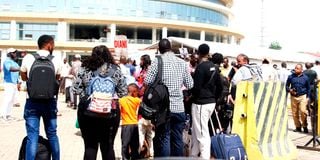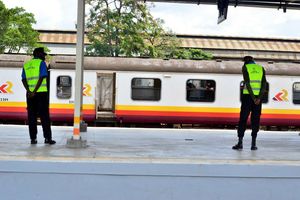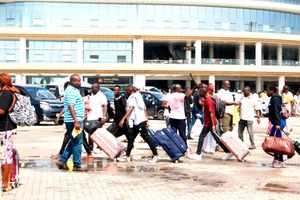
The Standard Gauge Railway Miritini Terminus in Mombasa.
When Kenya Railways sold a prime property along Nairobi’s Ojijo Road in Parklands to Guardian International Limited, it only asked for Sh77 million.
A few days after the deal was sealed, Guardian International sold the land to the National Social Security Fund (NSSF) for Sh178 million – thus earning Sh101 million by shuffling papers. Plot LR 209/6439 Ojijo was not alone.
The same was repeated many more times as Kenya Railways dished our various assets to the politically correct and as it became a site of sleaze. When Paul Ndungu, the Chairman of the Ndung’u Commission, which investigated the land grabbing and irregular allocations vice, looked at Kenya Railways and the land grab that had taken place, he was shocked.
“Kenya Railways Corporation is supposed to have surrendered land to the government and yet the same land ended up in private hands and was later sold to other State corporations.”
Ndung’u openly wondered “why the directors of respective corporations [did] not buy and sell land from their corporations directly instead of going through individuals who had acquired these lands illegally”. This week, as the Cabinet approved the plan to divide Kenya Railways Corporation into three entities — freight, commuter, and land development — memories of how the Railways got entangled in scandals have emerged from the rear. There have been efforts during the Mwai Kibaki and Uhuru Kenyatta presidencies to recover the railway assets. The Nairobi Railway station has been refurbished, and the decrepit wagons that littered the space were removed.
Lose prime properties
Whether Ruto’s move is to revamp the Railway or feed the buccaneers’ land appetite remains to be seen. With the land taken away from the Railways, the corporation would lose prime properties across the railway corridors, and these, according to State House, would later be handed over to “investors” to build what is being called “railway cities”. If the plot is to seize the railway land for political patronage, this will be the second time it will be happening. When it was incorporated in 1978 after the breakup of East African Railways Corporation, which operated under the defunct East African Community, the Kenya Railway was cash-rich. However, it had inherited a considerable workforce and a pension burden from the previous East African Railways Corporation.
More so, it faced competition from road truckers who started to compete with the “lunatic express”. As the Nyayo regime injected a dose of inefficiency into Railway leadership, corruption, and negligence of the infrastructure, the parastatal started to lose its place as a viable institution. From its weak position, its assets were up for grabs.
At one point on October 17, 1997, William Ntimama, then minister for Home Affairs and National Heritage, gazetted some of the Kenya Railway houses as national monuments. The National Museums had pointed out that the houses should be preserved as part of the history of Nairobi — and as colonial architectural pieces. But Prof Jeremiah Musuva, the railway boss, had already sold these houses to politically correct individuals. The houses included what was known as “European Staff Quarters” in Nairobi’s Ojijo Road and Junior European Staff Quarters in Parklands. These were quickly demolished and sold before Ntimama’s gazette notice. The houses were not advertised for sale, and they would feature in the Ndungu Report.
At the helm of Kenya Railways, Prof Musuva worked closely with the Commissioner of Lands Wilson Gachanja and most of the transactions bear their imprints. At one point, Prof Musuva was accused in Parliament by Prof Anyang Nyong’o of “selling off houses and land belonging to the Corporation at throwaway prices and, in some cases, at no price at all, without following the Government procedure”. By the time of his death, the Ethics and Anti-Corruption Commission was investigating his past. Some of the prime properties allocated in such a manner were in Nairobi’s Upper Hill — including the two-acre plot occupied by the British High Commission - and in Kileleshwa, where the Kenya Railway had various houses for its managers.
As Ruto seeks to reconfigure Kenya Railways, all eyes will be on the investors who will be building the “railway cities”. During the late 1980s and through the 1990s, the land-grabbing menace on public land became an avenue of political reward.
Land was seized for speculative purposes rather than development — resulting in the enrichment of a few people and abuse of power. Kenya Railways also suffered from irregular surrenders of its land to the Commissioner of Lands, who would allocate the land immediately to “applicants”.
After the allocation, the “applicant” would either subdivide the land with the consent of the Commissioner or sell it to different purchasers for millions of shillings. The Ndung’u Report established that State corporations were “politically pressurised to purchase illegally allocated public land at millions of shillings”. By then, especially in the first multi-party elections, Kanu was seeking money for its campaigns, and that is the period that the Commissioner of Lands transferred several parcels within Kisumu Block 7 to private individuals from the region to buy their loyalty. In 2019, the Ethics and Anti-Corruption Commission started a process to recover the land.
Many years later, it has taken lengthy court cases to recover some of the railway land. For instance, in December 2019, the Land and Environment Court ordered grabbers to vacate several parcels of railway land within Kisumu Municipality Block 7, which was set aside as a railway reserve. The land had been grabbed by politicos close to the Kanu regime and sold to unsuspecting third parties. By then, Kanu was using the railway land as bait to retain politicians. For instance, a law firm fraudulently sold Nyalenda Kenya Railways Corporation land. The railway assets have also been stolen through pseudo-privatization and fraudulent concessions.
In November 1999, the Kanu government decided to privatise Kenya Railways through a unitary concession. While Musalia Mudavadi, then Minister for Transport and Communication, had promised Kenyans that the award would go to the highest bidder, some railway assets ended up with cartels and brokers. Some of the railway assets were ostensibly “sold” to cater for pension payments – but pensioners continued to complain. Later, they were given some of the railway assets as compensation. It is unclear whether the Ruto regime will target land held by Railway pensioners.
According to Mudavadi, assets worth Sh1.4 billion had been disposed of without going through competitive bidding — an admission that government officials had broken the law. Nobody was prosecuted, even as MPs questioned Mudavadi whether the correct values were paid for the railway assets.
The only promise he made was that after the audit of railway assets is finalised, “it will give a clearer picture as to whether the right values were paid for each of the assets that have been disposed of to date or not.” That did not happen. By then, as Parliament was informed, railway godowns, land, and houses in various towns had been sold “at prices below the market value”. Once, Dr Mukhisa Kituyi told Parliament that a former minister during the Moi regime “bought rolling stocks of the Kenya Railways disguised as scrap metal and resold it to Kenya Railways through a company belonging to (the politician’s) wife”. While Mudavadi had promised the House that he would ensure that the railway properties were “ring-fenced”, that ring-fencing did not happen.
90 railway godowns
In Nairobi, the 90 railway godowns had been leased to politically correct individuals, and it was not until Mwai Kibaki came to power that the traders, who had pitched camp within the railway quarters, were evicted in May 2003 as Narc sought to restore the dilapidated corporation. Kibaki found that in Juja and Parklands, the railway houses had easily changed hands after being neglected and left to rot. It was a strategy used by Kenya Railway to offload the assets as worthless.
In Maragwa and Sagana, the railway sheds had been converted into churches. But Kibaki’s efforts to award a railway concession to a South African firm became so scandalous that few people discuss it. Some 13 years ago, the decrepit corporation was handed over to a South African company, Sheltam Trade Close Corp, operating as Rift Valley Railways, to make some economic sense.
They didn’t. Instead, the scandal of Rift Valley Railways emerged since the South African who was its face, Roy Puffet, was just a briefcase carrier. How Puffet managed to convince the Kenya and Uganda governments to hand him the running of the Kenya-Uganda railway for 25 years has always intrigued observers. As it later turned out, he had no capital and only had briefcase companies he had registered in Mauritius and South Africa.
In between, he sold his shell to Trans-Century, the miracle blue-chip company of the Kibaki era, and to an Egyptian equity fund, Citadel Capital, which desired a controlling stake in RVR. Trans-Century had invested $11 million — and the Egyptians had promised to turn around the Railway by investing $150 million. It was one of the Kibaki-era scandals.
The Kibaki men had told Kenyans that they would transform the railway system through the concessions. “As soon as the transaction goes through,” Njeru Githae, the Assistant Minister for Transport. He was quoted saying, “We will receive more than Sh900 million from World Bank, which will cater for all the years of pension and, consequently, all monthly pensions as they fall due… from July, (we will) be in a position to pay all the years of pension”. It was a wish.
On the eve of signing the multi-million-shilling concession, they realised that Sheltam – which had won the bid — was a briefcase company with a negative working capital of 398 million rands (approximately Sh3.3 billion). It could not raise the $5 million (Sh800 million) upfront fee required before he was handed over the railway assets.
Surprisingly, he was given the right to run what he named RVR without producing a cent. RVR then breached the concession agreement. As a site of corruption, the Railway had lived up to its billing. From the Standard Gauge Railway scandal in which land prices were inflated, President Ruto is eyeing Kenya Railways to ostensibly build ‘railway cities’. The Cabinet has approved. The proof of the pudding will be in the eating.







